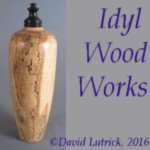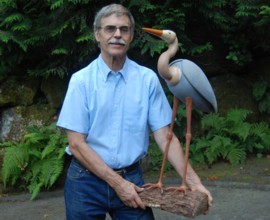I am a native of Texas. Most of my education was there, continuing through the University of Texas, at Austin. My undergraduate degree was in Chemical Engineering. I moved to Seattle in 1970 to pursue a graduate degree in air pollution engineering at the University of Washington. My wife, Anne, and I live in Issaquah, Washington.
I have had a lifelong interest in woodworking. Some 40 years ago, with the purchase of a lathe, I became a woodturner. I am largely self-taught. While living in Redding, California, the master turner Yosh Sugiyama provided much appreciated inspiration, encouragement and instruction, particularly with turned pieces featuring segmented sections of contrasting woods. Since moving back to Washington, the exceptionally talented turners of the Seattle Woodturners have provided examples of their work to inspire me and demonstrations of techniques that have added to my skills. Click here for early work and unusual pieces. Click on Idyl Wood Works to the left for a bowl-making photo sequence or right on my photo for the Rookery Project.
The national Connextion show featuring collaborative work combining lampwork beads and turned wood led my daughter Lara and me to create two pieces for the show. These are featured in the Vintage Galleries. The martini glass was included in an article in the Fall 2007 issue of the American Woodturner magazine. We authored an article describing two collaborative pieces in the September 2012 issue of The Flow magazine. Our latest collaborations are featured in the perles et bois pages. Techniques I use to make ornaments featuring sea urchin shells and "icicles" turned from various hardwoods are described in the Fall 2009 issue of American Woodturner. Erin, my second daughter, made a ceramic representation of a sea urchin that is incorporated into a piece in the Pre-2020 Portfolios.
The native, orchard and ornamental trees of the West Coast offer exceptional variety for the woodturner's art. Eastern Washington black walnut approaches that of the mid-western U.S. in color and texture while Claro walnut from California and Oregon offers bolder patterns and colors. Big leaf maple, redwood burl, black locust, madrone, cherry, deodar cedar, holly and cascara are some of my other favorites.
Among these, maple and holly are frequently found to be "spalted." In spalted wood, the fungi that digest components of the wood create dark streaks in zones in the wood. The partially digested (rotten) wood can be firm or extremely soft, colored or almost white, contributing to both the beauty of the finished piece, but also, making it difficult to achieve uniform surface characteristics.
A supply of wonderful 60-90 year old vintage banding from the Bouffard Freres firm of France adds color and pattern to a number of decorative pieces and furniture. Contemporary banding is also available and I have used various patterns, although I have a preference for the Bouffard banding.
For me, form remains the key to a visually pleasing piece of art. The color and grain of wood, and its surface texture, make art from wood uniquely natural. Look and touch!

